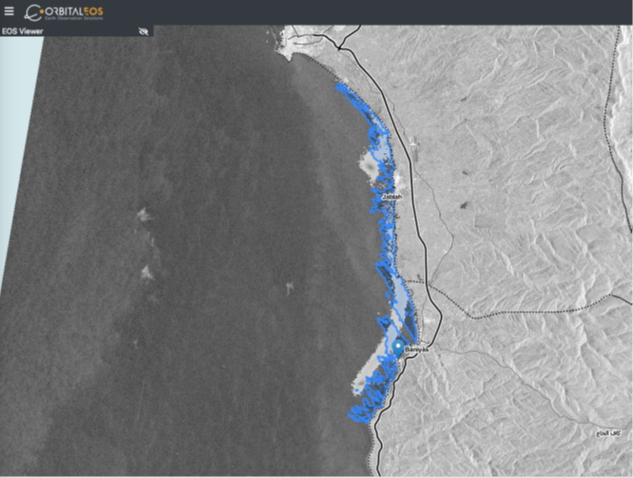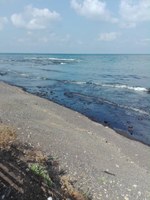Incident involving a fuel leakage into the Mediterranean Sea from the Baniyas thermal station, Syria – Sep 10, 2021
What we know about the incident
Date and Time of the spill: Monday, 23rd August, 1 pm (UTC+3)
Source and Quantity:
A leak occurred from one of the fuel tanks at the Baniyas thermal station as a result of cracks and wear that led to the leakage of fuel into the sea. According to the Syrian competent authorities, the damaged tank, contained 12,000 m3 of fuel, out of which an amount yet to be confirmed was pumped into nearby reservoirs. Part of the fuel was contained whilst the rest leaked into the sea.
Oil spill evolution and forecast:
REMPEC activated the Mediterranean Operational Network for the Global Ocean Observing System (MONGOOS) (CMCC, Orbitaleos and Orion), member of the Mediterranean Assistance Unit. The models and predictions have been consistent with the satellite images acquired by MONGOOS:
For 12 –14 September, the oil mainly demonstrated a significant beaching on the
coastlines from Baniyas to Latakia.
Estimation of sea surface oil volume and sea surface polluted area based on the selected 27 satellite-born detections allows us to assume that:
For 24–28 August, the significant continuous/semi-continuous spill has occurred from the Baniyas thermal plant;
During 29 August–1 September, some impulsive leakages could be possible;
For 2 September–4 September, the leaks from the Baniyas thermal plant have stopped.
For 5 September–12 September, some moderate or minor oil pollution has been still visible at the sea surface in the coastal area from Baniyas to Latakia. It might be probably related to some unknown small leaks or to the oil that re-enters the sea from the uncleaned coastlines or to both.
03:00 UTC on 14 September 2021

It seems that there is no longer drifting oil at sea and the threat of pollution of the areas of the eastern coast of Cyprus and southern western coast of Turkey is decreasing. However, the situation remains critical along the Syrian coastline, north Banias, where the spilled quantities are beaching since 25 August.
Oil mass balance shows:
According to the models, 40% of the initial oil mass evaporated by 27 August; 14 % was drifting on the sea surface as of 31 August, and 44% was on the Syrian shoreline. The natural dispersion of the oil in the water column was negligible.
REMPEC response to the incident: a brief timeline
On Wednesday 25th August
- REMPEC was informed about the incident by the Syrian competent authorities
- The Syrian authorities informed REMPEC that cleaning operations were undertaken on the affected areas with limited capacity and requested assistance to REMPEC to support the response operations
- REMPEC activated the Mediterranean Operational Network for the Global Ocean Observing System (MONGOOS), member of the Mediterranean Assistance Unit (MAU) for the provision of regular simulation and prediction of the movement of the spill.
- Since then, REMPEC has been continuously in contact with the Syrian competent authority (Director of Environmental Safety Directorate, Ministry of Local Administration and Environment)
On Friday 27 August 2021
- REMPEC notified the incident to the neighbouring countries, i.e. Cyprus, Israel, Lebanon and Turkey and provided regular forecast updates.
On Monday 30 August 2021
- A crisis management meeting was organized and attended by representatives of the Ministry of Local Administration and Environment, UNEP/West Asia, UNEP/MAP, IMO and REMPEC. The objectives of the meeting were to obtain updated information on the pollution, the impacted areas, measures undertaken by the Syrian Government and REMPEC and to define the course of action.
- REMPEC has been in contact with Cyprus and Turkey to assess the situation, ascertain the arrival of oil on the Cypriot island, take stock of the preventive measure undertaken by the individual coastal States, and endeavour coordination of efforts
- Cyprus mobilised the EMSA vessel “Alexandria”, and requested REMPEC to notify Greece and Israel about the potential activation of the Sub-regional Marine Oil Pollution Contingency Plan between Cyprus, Greece and Israel, subject to the evolution of the situation, within the next days. The said plan was developed with the support of REMPEC and signed in May 2018.
- the simulations were re-started from the updated satellite-based slick polygons
Cyprus response to the incident: a brief timeline
Satellite images received on the 29th of August through EMSA illustrated a large area of over 500 nm2 likely covered in oil slick, moving away from Syria towards the northeast of Cyprus.
In the early hours of the 30th of August, the National Response Team, under the command of the Director of the Department of Fisheries and Marine Research (DFMR) convened at the National JOINT RESCUE COORDINATION CENTER (JRCC) to assess the situation, to collect, cross examine, verify and analyze available data.
Commercial vessels and fishing boats were tracked and instructed to provide information on the situation. Information received verified the presence of what looks like oil sheen, part of which covered a small area of the coast of northeast Cyprus by the early hours of the 31st of August.
On the 1st of September, the Team continued the observations and monitoring as updated data were collected through surveillance by patrol aircrafts and naval patrol vessels east of the coast of Cyprus so as to facilitate the detection of sizeable oil slicks as well as through processing information gathered by REMPEC and other means including independent sources.
Updated CleanSeaNet Alert reports with alleged sites of pollution were being inspected on site but no further pollution incident or traces of oil slick have been tracked or verified in the area of the RoC in which the Government of the RoC exercises effective control.
Further to the satellite images from EMSA, oil spill dispersion forecasting models were utilized to improve decision making and if necessary, to enable authorities to engage in effective emergency response measures.
Cyprus team of experts, through continuous data tracking, gathering, processing and evaluation, came to the conclusion that the oil slick area is characterized as oil sheen which gradually disperses and dissolves without so far affecting the shores of the area of Cyprus that the Government exercises effective control.
The team had also built up highly unlikely scenarios but within the realm of possibility in the event that heavy fuel leakage from the source of pollution in Syria continued unabated and moved towards the eastern coastline of Cyprus. To this end, Cyprus informed the authorities of Israel and Greece through REMPEC on the potential activation of the Sub-Regional Marine Oil Pollution Contingency Plan between Cyprus, Greece and Israel. Precautionary measures were also taken, through mobilising units, anti pollution equipment and vessels. EMSA was also notified to mobilize the anti-pollution vessel ALEXANDRIA in the area.
Cyprus has since used updated CleanSeaNet Alert reports with Satellite images from EMSA and oil spill dispersion forecasting models with simulations of the oil slick’s trajectory prolonged to the 9th of September, as well as monitoring through daily naval and aerial patrols.
On the 5th of September, after rigorous assessment of the situation and having thoroughly studied the newly updated aforementioned simulations which predict no further pollution incidents on the shoreline of Cyprus, the crisis was terminated. To this end, the demobilization of the oil spill response vessel “ALEXANDRIA” has done.
Nonetheless, Cyprus continues to this date to closely monitor the situation through satellite images and in situ surveillance with naval means.
Next steps
The meeting held on 30 August with the Syrian authorities defined the following next steps including:
- the possible mobilisation in Syria a of an expert of the Mediterranean Assistance Unit (MAU) to assess the situation along the affected coastline, identify the most appropriate response techniques at sea and onshore, and to define the need in terms of means and personal,
- Assess the need for assistance from Contracting Parties to the Barcelona Convention,
- Remote assistance to provide technical advice and trainings to local personnel,
- Support Cyprus and Turkey as required,
According to the mandate of REMPEC, one of its tasks consist in assisting coastal States in the Mediterranean region who request emergency assistance, either directly or via other regions, as well as securing assistance from other Parties, who are close to their region or from outside their region.
Earlier this year, REMPEC provided assistance to Lebanon in the context of the pollution which affected both Israel and Lebanon.
Related Articles and communications:


